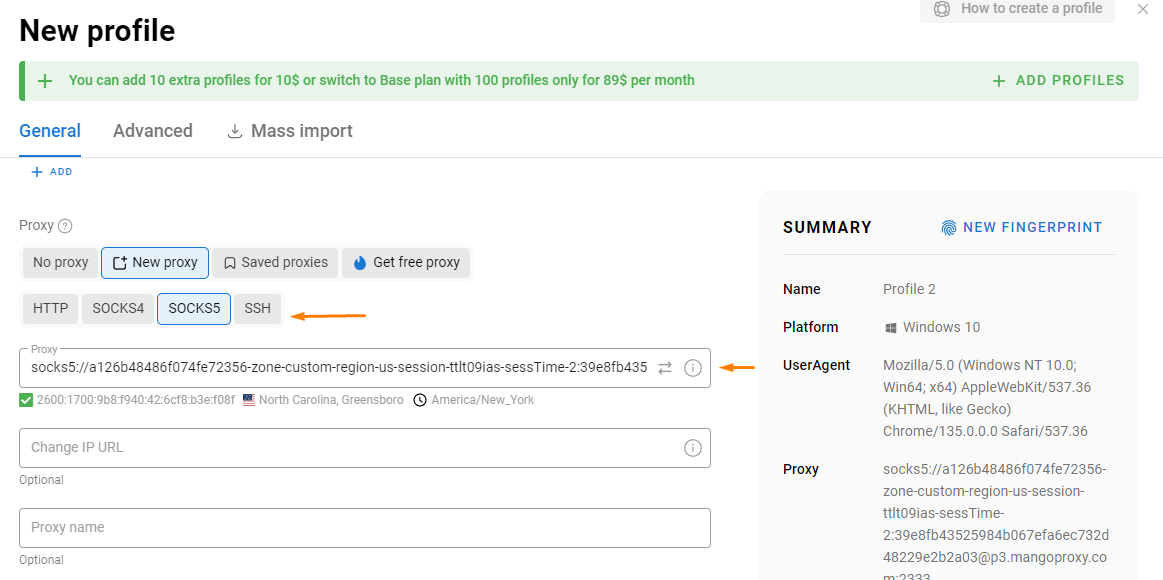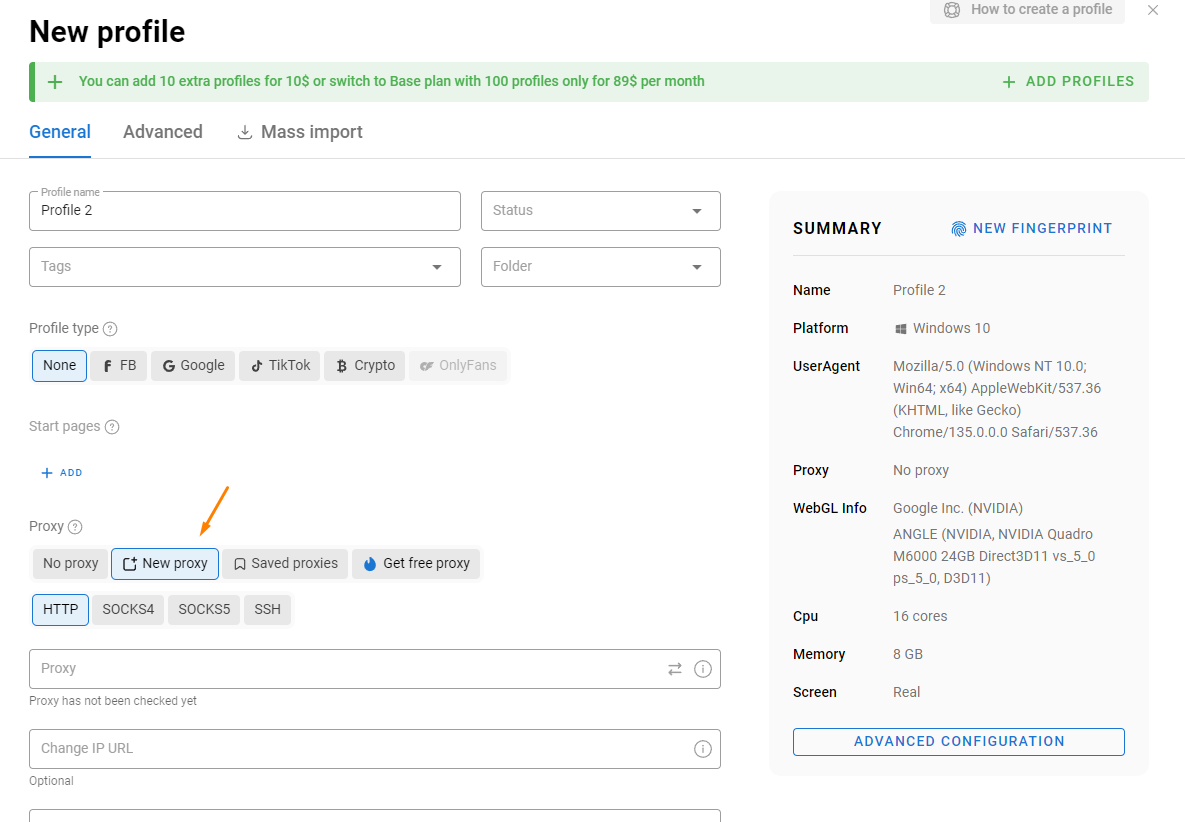Dolphin Anty
Creating a profile in Dolphin Anty
- Launch Dolphin Anty on your computer
- Click the "CREATE PROFILE" button in the upper right corner of the interface (highlighted with an orange arrow in the screenshot)

Interface of Dolphin Anty with the profile creation button
- In the window that opens, fill out the main profile information:
- Name: Enter a unique profile name (for example, "Mango Proxy - USA")
- Tags: If necessary, add tags to organize profiles
- Status: Choose a profile status from the drop‑down menu
- Folder: Distribute the profile across folders for easier management
- Profile type: Choose the profile type depending on its purpose (Facebook, Google, TikTok, etc.)
Configuring a proxy in the Dolphin Anty profile
- On the profile creation or editing page, find the "Proxy" section (usually located at the bottom of the main settings)
- Click the "New proxy" button (highlighted with an orange arrow in the screenshot)

Proxy settings section in the Dolphin Anty profile
- In the panel that appears, select the appropriate proxy protocol:
- HTTP (basic protocol)
- SOCKS4 (for tasks requiring SOCKS4)
- SOCKS5 (recommended for most tasks as the most stable and secure)
- SSH (for tasks requiring SSH tunneling)
- Enter your proxy string in one of the following formats:
- For SOCKS5:
socks5://username:password@host:port - For HTTP:
http://username:password@host:port - For HTTPS:
https://username:password@host:port
- For SOCKS5:

Proxy input form with a sample connection string
- Example of a proxy string (as shown in the screenshot):
socks5://login-zone-custom-region-us-session-ttlt09ias-sessTime-2:password@p3.mangoproxy.com:2333
- If necessary, fill in the additional fields:
- Change IP URL: The URL for changing the IP address if you are using proxy rotation
- Proxy name: Add a descriptive name for the proxy (for example, "Mango US Chicago")
Testing the connection and launching the profile
- After entering the proxy data, click the connection test icon (if available) to test the connection
- Upon successful testing, you will see confirmation with information about the current IP address and location
- Finish configuring the profile by adjusting other parameters if necessary (UserAgent, WebGL, Canvas, etc.)
- Save the profile by clicking the appropriate button
- Now you can launch the profile using the "START" button in the profile list
Important: After successfully creating a profile with Mango proxy, it is recommended to back it up or save the settings to avoid having to configure it again in case of failures.
Best practices for working with Mango Proxy in Dolphin Anty
For managing social media accounts
- Geo‑matching: Use IP addresses from countries that match the account registration region
- Separate profiles: Create separate profiles with unique proxies for each account
- Session stability: For social media work, set longer sessions (from 30 minutes to several hours)
- Natural activity: Avoid abrupt changes of IP addresses and countries when working with the same account
- Documentation: Keep a record of which profiles with which proxies are used for specific accounts
For multi‑accounting
- Organization by projects: Group profiles into folders by project or client for convenient management
- IP rotation schedules: Implement regular IP change schedules for projects with high security requirements
- Documenting successful configurations: Save proxy configurations that work well with specific platforms
- Different fingerprints: Use different browser fingerprints for each profile
- Session management: Distribute activity across different time intervals to simulate natural user behavior
For web scraping
- Geographic diversity: Use proxies from different geographical locations
- Session optimization: Adjust session duration depending on the volume of scraping
- Monitoring performance: Monitor proxy performance and adjust settings as needed
- Delays between requests: Implement appropriate delays between requests to avoid detection
- User‑agent rotation: Change the User Agent along with the proxy for maximum anonymity
Troubleshooting common issues when integrating Mango Proxy with Dolphin Anty
Problem: Unable to connect to the proxy
Solutions:
- Check that the username and password are entered correctly
- Ensure that the selected protocol (SOCKS5, HTTP, HTTPS) is supported by your version of Dolphin Anty
- Check the status of your Mango Proxy subscription
- Double‑check the format of the proxy string (should be: protocol://username:password@host:port)
- Temporarily disable firewall or antivirus software that may be blocking the connection
Problem: Slow connection speed
Solutions:
- Choose a Mango Proxy server geographically close to your target website
- Switch to the SOCKS5 protocol for potentially better performance
- Check the speed of your internet connection
- Reduce the number of simultaneous connections through the same proxy
- If speed is critically important, consider using dedicated proxies instead of residential ones
Problem: Unstable connections or frequent disconnects
Solutions:
- Increase session duration in Mango Proxy settings
- Check the stability of your primary internet connection
- Try another proxy server region
- Make sure you are not exceeding the limits on the number of simultaneous connections
Problem: Websites detect proxy usage
Solutions:
- Ensure that the browser fingerprint in Dolphin Anty matches the proxy location (language, time zone, OS)
- Rotate proxies and fingerprints more often
- Use residential proxies (such as Mango Proxy) instead of cheap datacenter proxies
- Limit the number of requests per proxy and distribute workload across multiple proxies
- Combine proxies with other anti‑detect measures (multi‑accounting browsers, profile isolation)